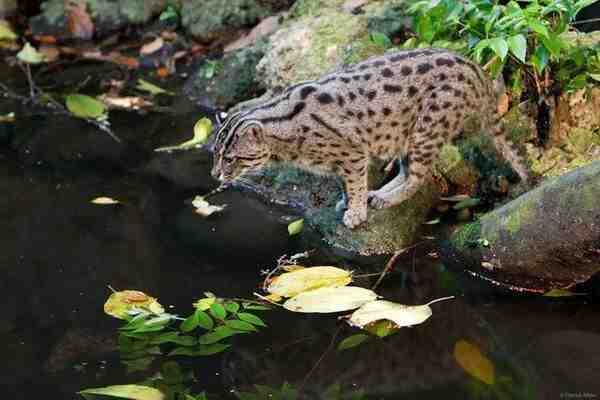Prionailurus viverrinus
IUCN
LCBasic Information
Scientific classification
- name:Prionailurus viverrinus
- Scientific Name:Prionailurus viverrinus,Fishing Cat , Chat Pêcheur ,Gato Pescador,civet cat, fishing cat, fishing cat
- Outline:Carnivora
- Family:Schizopoda Felidae Ocelot
Vital signs
- length:66-85cm
- Weight:5-10kg
- lifetime:10-12years
Feature
A wild cat that loves water
Distribution and Habitat
Fishing cats are mainly distributed in southeastern Asia, mainly including northern India, Nepal, Sri Lanka, Myanmar, Thailand, Vietnam, Malaysia and other countries. Fishing cats are only produced in Taiwan in China. 2 to 3 skins have been obtained, but it may be misidentified. Abroad, they are found in India, Indochina, Sri Lanka, Sumatra and Java in Indonesia. They mainly appear in wetlands from India to Southeast Asia and Indonesia.
Fishing cats live in bushes in forest areas, reeds along rivers, swamps and evergreen forests on tropical coasts. They are good at swimming, but often move and stay on the ground and are not good at climbing. They live in areas with abundant freshwater resources such as rivers, streams, reed wetlands and mangrove wetlands below 1,500 meters above sea level.
Appearance
The body is stout and the fur is rough. The fur color ranges from ash, yellow-gray, gray-brown to light yellow-brown. The back is darker than the sides. The body is covered with brown-black stripes and spots. The abdomen is white. The throat forms two collars and there are horizontal stripes on the chest. There are also semi-webbed feet between the toes, which are suitable for activities in water.
The head is wide, the snout is long, the ears are small and round, the back of the ears are black, and there are obvious white spots in the middle. They are short and stout, with short limbs. The fur color of the whole body is gray-yellow, covered with long longitudinal dark brown or black spots. The fur on their abdomen is white and also has spots.
Fishing cats can breed all year round, but in northeastern India, the breeding season is in spring and summer from March to June, and the peak season is in March and May. Fishing cats will build their nests in reeds. In spring, they mate. Th
Details
Fishing cats are slightly larger than domestic cats, with shorter tails, about half the length of their bodies.

Fishing cats and leopard cats both belong to the genus Leopard Cat, and they are closely related. Their body markings have many similarities, so people often mistake fishing cats for leopard cats. In fact, the two cats can be easily distinguished by looking at their body shape and head: the fishing cat is larger in body shape, has a larger head, and is short and fat; the ocelot is smaller in body shape, has a smaller head, and is agile.
As for the excellent water ability of the fishing cat, some people believe that they have partial webbed feet between their toes and have dense fur, which is suitable for activities in the water to help them swim and hunt freely in the water. However, later studies have found that the webbed feet between their toes are not more developed than those of the North American bobcat. And because there are webbed feet between the claws and toes, the claws cannot be completely wrapped, and their claws cannot be completely retracted, and they are always stretched forward.

Fishing cats are secretive and active at night. One of their main prey is fish, including about 10 species. They will use one paw to slap the water surface, making the fish think that there are insects coming, to attract the fish, and then successfully eat them. When fishing, fishing cats crouch on the rocks or small cliffs by the river. When small fish swim close, they suddenly use their claws to catch them and throw them onto the shore. Fishing cats are the best swimmers among cats. They use their tails to control their direction. It also preys on other aquatic organisms, including frogs, freshwater lobsters, crabs, crustaceans and mollusks, as well as terrestrial organisms, including rodents, birds, calves, goats, dogs and carcasses of large animals. In Pakistan, people have also seen them jumping into the water to catch waterfowl. Even in India, fishing cats eat grass. Fishing cats are ferocious and dare to attack animals much larger than them. They are not easy to domesticate.
Due to the gradual reduction of wetlands in Southeast Asia where fishing cats live and overfishing by humans, the number of fishing cats has dropped sharply, and its protection level has been adjusted from vulnerable to endangered. Fishing cats have been confirmed extinct in Afghanistan and are extremely rare in Malaysia and China; and their numbers are also decreasing significantly in their existing distribution areas. Other threats to survival include water and chemical pollution, hunting for their beautiful fur or as wild game, etc.
There are 22 animal associations in North America that have caged fishing cats. As of December 2005, the total number of fishing cats owned by all animal associations is 72. Except for Bhutan, Malaysia and Vietnam, other countries and regions in the distribution area of fishing cats have taken protective measures.
The IUCN Red List lists it as Endangered (EN) and it is listed in Appendix II of the Convention on International Trade in Endangered Species of Wild Fauna and Flora.
It is listed in the second level of the "List of National Key Protected Wildlife in China".
Protect wild animals and stop eating game.
Maintaining ecological balance is everyone's responsibility!








